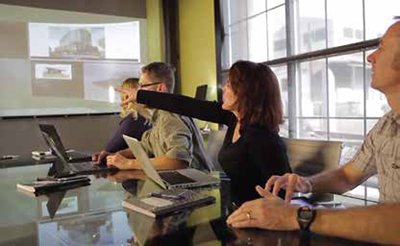The economy is flickering back to life, and in many cities, that’s reflected in the cost of commercial real estate. Downtown Manhattan rents, for example, increased 17 percent over just the past year, with trophy addresses such as Madison and Fifth averaging $127 per square foot, according to Cushman & Wakefield’s annual study.
One way that businesses, colleges and houses of worship are responding is by scrutinizing their AV facilities for opportunities to maximize their return on investment (ROI). Often their focus is videoconferencing suites and other rooms whose designs limit their ability to be used for more than a single application. Unless those rooms are used all day, every day, they’re not wringing all of the ROI out of that real estate —or the five, six or seven figures’ worth of AV gear in them.
Mersive’s Solstice 2.0 collaboration system in action “Nobody wants to do the dedicated conference suite anymore if they don’t have to,” said Justin O’Connor, Biamp Systems audio product manager.
The ROI scrutiny isn’t limited to high-cost markets, either.
“Real estate may be less expensive in the Midwest, but it doesn’t change the fact that coming out of a tough economy of the past five years, everybody is taking a look at everything,” said Derek Paquin, principal at Sensory Technologies, an integrator with offices in Illinois, Indiana and Ohio. “This is one area: ‘Let’s utilize [what we have] as much as possible before we look to increase space.’”
Sometimes the strategy includes a shift away from permanently installed gear toward equipment that can be shared among multiple rooms. For example, the U.S. Council of Catholic Bishops’ headquarters has a 64-seat boardroom that’s used only four times a year. It has several other meeting rooms that are used more regularly, but they don’t have microphone systems.
Media Vision recommended putting a wireless system in the boardroom so those 64 mics could be used elsewhere the rest of the time. “It turned out to be a cost savings for them and gave them a lot of additional functionality,” said Patrick Herlihy, Media Vision director of sales for North America.
That’s one example of a more specific trend within the broader multipurpose trend.
“We are seeing trends within this overall embrace of multipurpose spaces, including one where budgets for one larger C-suite space are being reallocated to a few smaller meeting spaces,” said Tim Troast, Middle Atlantic Products director of product development. “The benefit is more areas that are accessible for group collaboration, and outfitted to accommodate any meeting need.”
Ease of use also directly affects ROI. For example, imagine a large conference room with moveable walls that can partition it into three smaller meeting spaces. The control system must have a graphical user interface that’s intuitive enough for rank-and-file employees to configure sources and outputs in each space.
If it’s complicated, then at least three ROI-busting things can happen. The company has to budget for a tech to configure that room before every meeting. If that’s not an option, then employees get intimidate to the point that they avoid using AV in their meetings. Or befuddled employees inundate the help desk, so that staff’s productivity drops because it has to spend so much time holding hands.
Control system presets are an ideal way to avoid those three problems. For example, in a dividable room, the moveable walls could have electrical contacts that automatically adjust the PA and projectors based on whether they’re open or closed. In a fixed or dividable space, the control panel presets could be as simple as “classroom” or “boardroom,” or icons based on how the furniture is arranged.
“In multipurpose rooms, the programming is the No. 1 most complicated aspect,” said George Meglio, IVCi regional sales director. “If the receptionist can come in the room and fire it up, we’ve succeeded. If it’s not easy to use, there will be no ROI.”
To maximize ease of use and ROI, consider working with an AV integrator or consultant. Their vendor relationships give them advance insights into how technology is evolving, which affects what’s possible in multipurpose rooms.
“AV technology evolves at light speed,” said Jim Ridgway, director of event services at the Georgia World Congress Center, which has dozens of multipurpose rooms. “More and more buildings are bringing in an outside AV company to help manage that process for them.”
info
Cushman Wakefield
www.cushmanwakefield.com
Media Vision USA
www.mediavision.com
